Categories
Subjects
Authors
Artists
Venues
Locations
Calendar
Filter
Done
April 9, 2019 – Feature
Hong Kong Roundup
Marcus Yee
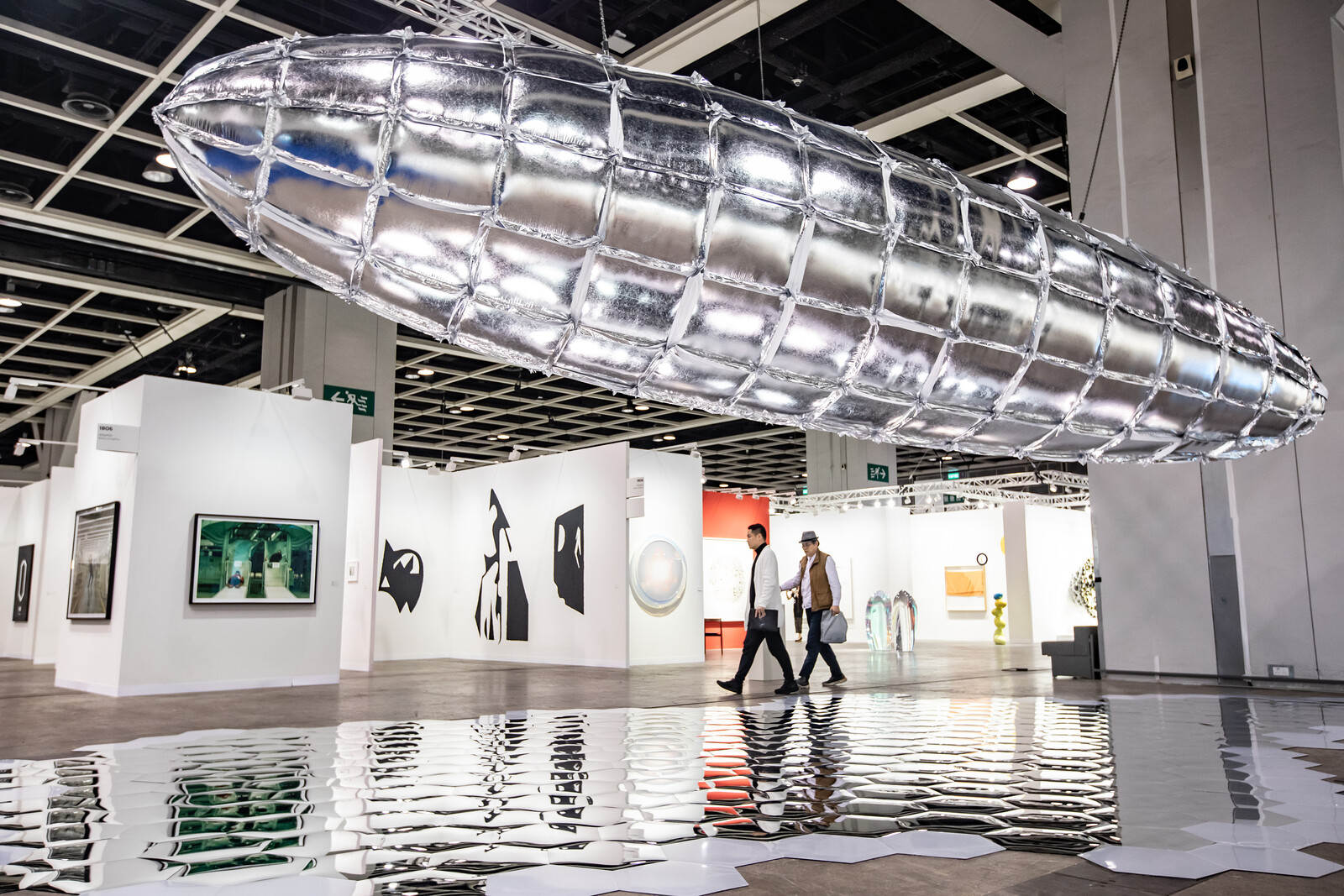
Hong Kong floats, at least according to Xi Xi’s short story, “The Floating City.” In this sensitive portrait of Hong Kong, the city has stabilized into myth, while its inhabitants have turned into a group of happily amnesiac petits bourgeois, desiring only for peaceful homes. After a few years of toil, the city became prosperous and cosmopolitan, boasting art festivals and books from all over the world. The floating city was a miracle.
This sensation of floating is best captured by Art Basel Hong Kong’s public art section, “Encounters.” In Elmgreen & Dragset’s City in the Sky (2019), the global financial metropolis is literally turned upside-down; whereas Lee Bul’s Willing To Be Vulnerable – Metalized Balloon (2019), a shiny emblem of high modernity’s aspirations and failures, hangs languorously from the convention center’s ceiling. By virtue of their scale, these spectacles were well received by a public hungry to update their WeChat or Instagram feeds. At same time, looking at these monuments aloft in the air, the question remains: What keeps everything afloat?
This was also the source of trepidation by inhabitants of Xi’s floating city. Unnerved by the possibility of an Icarian fall, they wished to pack up and leave the city …
April 3, 2018 – Review
Art Basel Hong Kong
Alvin Li
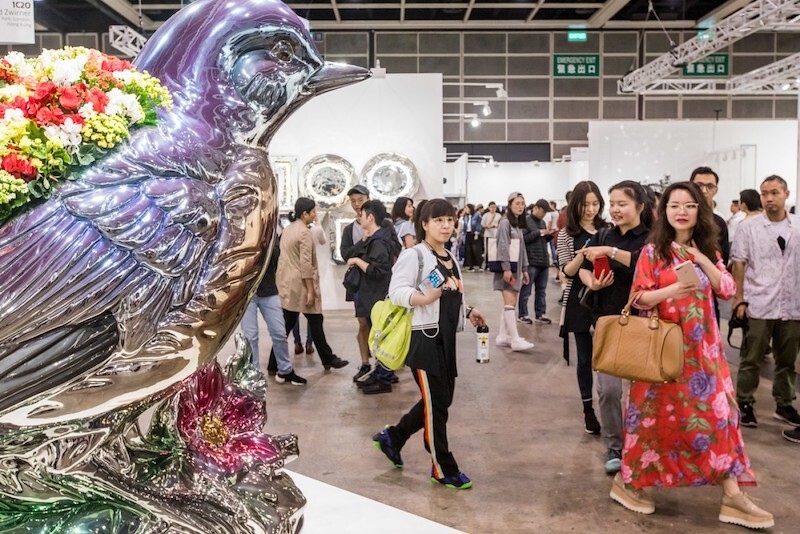
Those of us who willingly attend and return to Art Basel Hong Kong must still see hope in the global convolution of capital. If you don’t, call yourself a pessimist. When this hope is solely financial—which seems to be the case for many galleries—it belies a detached cynicism that ridicules the very nature of hope. For others, hope can be a polyvalent state of mind, geared toward the possibility of provoking social change in a hyper-capitalist context.
The global #MeToo movement finally had a breakthrough moment in China in March earlier this year, when Xu Gang, a former professor at the University of Illinois at Urbana–Champaign and the Sichuan Fine Arts Academy, was removed as the curator of the forthcoming 2018 Shenzhen Art Biennale following accusations of sexual and physical assault lasting decades. (The forthcoming “Xi’An Contemporary Art Exhibition 2018,” of which Xu acts as chief curator, has yet to respond.) While most galleries at Art Basel Hong Kong did not openly react to the news—Gang’s dismissal occurred 15 days before it opened—this fact provides an important context for the appreciation of works at the fair, in which booth presentations of defiant works by and about women stand out.
In the main …
June 16, 2017 – Review
Art Basel
Daniel Horn

The air was hot and filled with din. Art Basel 2017 opened on Tuesday as a more laid-back affair than the previous two editions, but the overall mood was nonetheless upbeat. And how could it not be, given the breathtakingly vulgar fun-fair installation Now I Won (2017) by Swiss artist Claudia Comte, greeting and luring (and driving away) visitors entering the Messeplatz? Teutonic in execution and style, it offered various competitive games in which Comte’s artworks could be won while emitting a blaring mix of Schlager and hoedown techno. The proceeds from its two-franc ticket sales go to some eco non-profit, making the whole thing feel timely in its tribal tattooed populism-meets-greenwashing outlook, compared to resuscitations of 1990s virginal sharetopias like Rirkrit Tiravanija’s al fresco curry Do We Dream Under The Same Sky two summers ago, or like the kind of applied progressive “artistic research” embodied by Oscar Tuazon’s Zome Alloy architecture, underwritten by 2016 elites.
Inside, the demographic barometer had largely swung—or arguably remained—to a groomed, white Euro-set with noticeably Francophone accents to be heard nearly all around, perhaps due to some Emmanuel Macron high spiking French (or was it Belgian or in fact Swiss?) purchasing confidence and a restored …
March 25, 2017 – Review
Art Basel Hong Kong
Daniel Szehin Ho
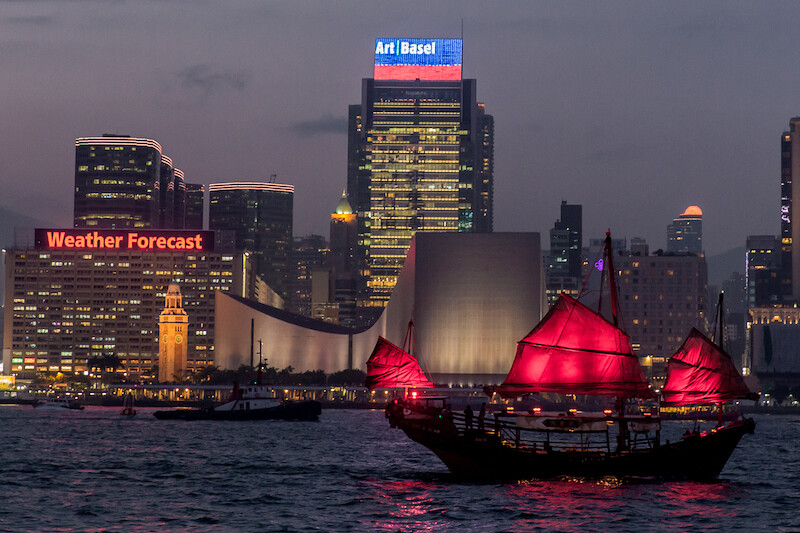
Twenty years after the handover of sovereignty from the United Kingdom to China, Hong Kong stands at a crossroads. The generation to come of age in the intervening decades has become restless, frustrated by the rejection of demands for universal suffrage (the election for the next Chief Executive takes places tomorrow, March 26, but only 1194 people have a ballot[1]). That, along with sky-high property prices and low social mobility, has fueled a cycle of disenchantment that has set the territory on a collision course with Beijing. Feelings are running high.
Art Basel Hong Kong stands at some remove from all this, but is nonetheless pervaded by a sense of urgency. Presented by 10 Chancery Lane, Hong Kong and P.P.O.W., New York, in the Encounters section, which hosts large-scale sculpture and installation, Dinh Q. Lê’s The Deep Blue Sea (2017) distorts news images of migrants crossing the Mediterranean to seek asylum onto 150-foot-long stretches of photo paper. Transforming photography into sculpture and creating an alluring installation redolent of streams and waves, the work digs into media (mis)representations of the refugee (the figure of which, as Giorgio Agamben has famously argued in his 1995 book Homo Sacer, removes the fig leaves of …
April 7, 2016 – Feature
Hong Kong Roundup
Qinyi Lim

Despite this year’s Art Basel Hong Kong taking place over the coldest and wettest Easter experienced in Hong Kong since 1978, the buffeting winds and rain did little to deter the audience from exploring beyond the confines of the Convention Center. Rather, the weather provided a common topic of commiseration between people with umbrellas lost, broken, and unlawfully gained.
In these exchanges often lay the contrasting perspectives of a city held in a delicate balance between the celebration of possibilities and entrepreneurship, the oft-perpetuated stereotype of being exotically between the East and West, and the anxious foreshadowing of an impending loss of governmental and personal autonomy in light of an encroaching mainland China. This heady mix of apprehension and celebration became apparent in the different energies and temporalities channeled into events and exhibitions outside of the fair—a mixture of elation, of adulation, and of consideration.
One of these events was Alexander Geist and Ming Wong’s performance for the album launch of That Girl (2016), a commission by UBS, which the duo presented twice in one night—first at a private party hosted by UBS at Ping Pong, and secondly at a public “Emergency Party” hosted by Flash Art, ArtReview Asia, and LEAP. Geist …
March 24, 2016 – Review
Art Basel Hong Kong
Aileen Burns / Johan Lundh

The maxim “less is more” hardly springs to mind when thinking about Art Basel Hong Kong. Yet Art Basel’s global director, Marc Spiegler, uttered those very words during the media reception for this year’s edition, arguing for quality over quantity and noting that all three of the franchise’s fairs in Basel, Miami Beach, and Hong Kong have been shrinking steadily in terms of both exhibiting galleries and major installations. While the overall number of exhibitors at Hong Kong has diminished, the percentage with a permanent presence in the Asia-Pacific area has grown steadily: a little over half of this year’s participants have spaces in the region. This despite the turmoil in the Chinese economy, which—allied to the fact that this year’s auction sales have yet to match those in 2015—prompted some discussion at the media reception as to whether Art Basel expected reduced sales. Art Basel’s director for Asia Adeline Ooi was quick to point out that, as a regional commercial hub, Hong Kong attracts collectors from elsewhere than China.
All of the familiar Art Basel elements can be found throughout two halls of the Hong Kong Convention and Exhibition Centre, situated on the city’s bustling harbor. Encounters—Hong Kong’s answer to …
March 16, 2015 – Review
Art Basel Hong Kong
Ming Lin
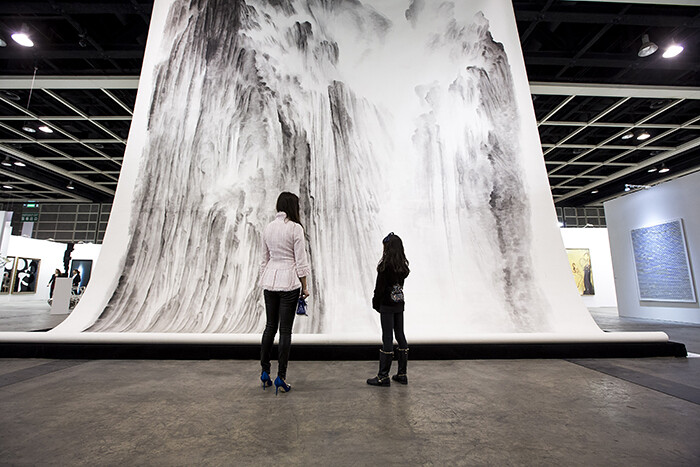
In its third iteration under Swiss direction (Art Basel purchased the Art Hong Kong fair in 2013), Art Basel Hong Kong features an abundance of works that wobble, waft, or otherwise cross the threshold between different modes of sensory perception, in attempts to break with an exhibition format and context that otherwise utterly negates the potential for organic encounters and experiences. Within the sterile grounds of the Hong Kong Convention Centre, the works that appeal to the broader sensorium are the ones that manage deliver both aesthetic and conceptual acuity.
Paradoxically, Hong Kong is a sensuous city. Its dewy sub-tropical climate is a contributing factor, but so too is the sheer scale of both the built environment and the social changes that elicit such visceral reaction. This can be unpleasant (vertigo-inducing heights, over-crowding) or sanctifying (air-conditioning, elevated walkways, and perfumed tissues), and the everyday is a constant negotiation of polarizing physical, ideological, and historical elements. In the commercial context, such colonization of airways is palpable, as various enterprises compete for one’s attention—shopping malls pump patented aromas, advertisements play musical jingles—thus it is perhaps unsurprising that in the context of the art world one finds accentuated stimulation.
At the fair, several galleries have …
May 15, 2014 – Review
Art Basel Hong Kong
Melanie Pocock
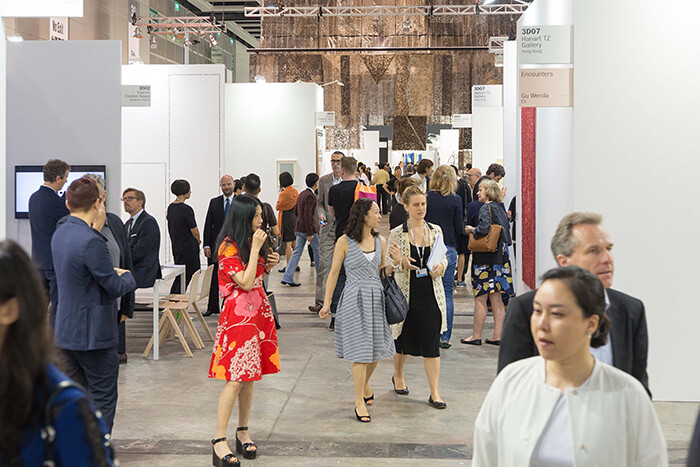
At an art fair like Art Basel Hong Kong—now in its second year—what it means to be “truly global” warrants some reflection. For the fair’s global director Marc Spiegler, it meant increased participation from western galleries, artists, and collectors, creating a more “global” market for Asian art and a seemingly more “global” art for Asia. The European and American-centric nature of Spiegler’s definition aside, this shift did allow for a greater diversity of presentations, many coming from younger galleries keen to respond to the context of the fair itself. Overall, the participating artists appeared conscious of such problematic qualifications of the global, leading to works and showcases that emphasized the latter’s increasingly oblique and virtual character.
This scenario was reflected in several works in the curated Encounters section of large-scale sculpture and installation works—notably Yu Cheng-Ta’s The Letters (Live Performance) (2014), presented by Chi-Wen Gallery from Taipei. Comprising a green-screen set, in which actors periodically read aloud spam emails about advance-fee fraud schemes, The Letters raises the question of exactly what encounters in the digital realm entail, as well as the ease with which identities can be concealed within it. That exchanges of capital often drive such confrontations is also significant …
June 13, 2013 – Review
Art Basel
Aoife Rosenmeyer
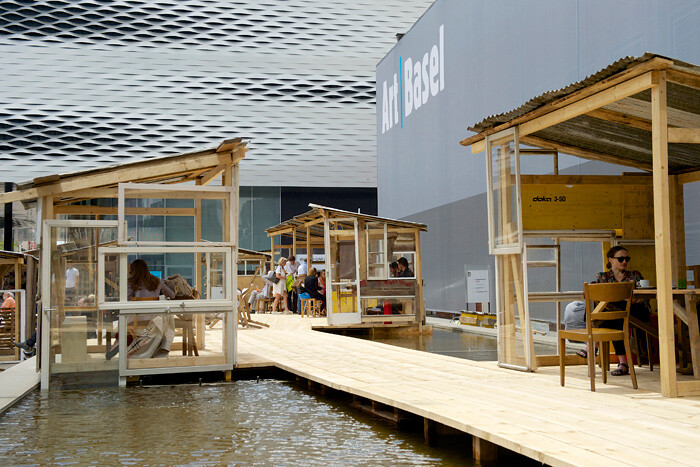
Art Basel is vast. It always is. But this year it’s larger than ever, with the site expanded by some 20%. Consequently, Design Basel is now brought into the fold on Messeplatz and the Swiss Art Awards are around the corner but in an improved space. The Basel experience has become more streamlined, and the rudimentary shelters created by Tadashi Kawamata outside the main entrance, reusing pallets and other waste, provide intimate meeting and eating spaces. But why, oh why, did it have to be called Favela Café (2013), in this richest of cities at this temple of conspicuous consumption?
Inside, I decided to hit the Unlimited section first, as one is wont to do, and where the fair feels more curated, and it is—with really large works on display, whereas the Statements section for younger galleries was trimmed down, and there was a new Feature section of truly “curated” stands. (Are there other galleries who put their selections together in the dark?) Following hot on the heels of the Frieze New York, Art Basel’s first Hong Kong fair, and the Venice Biennale to boot, the strain is showing on a lot of gallerists. Many are capitalizing on their artists’ presence …
May 23, 2013 – Review
Art Basel Hong Kong
Venus Lau
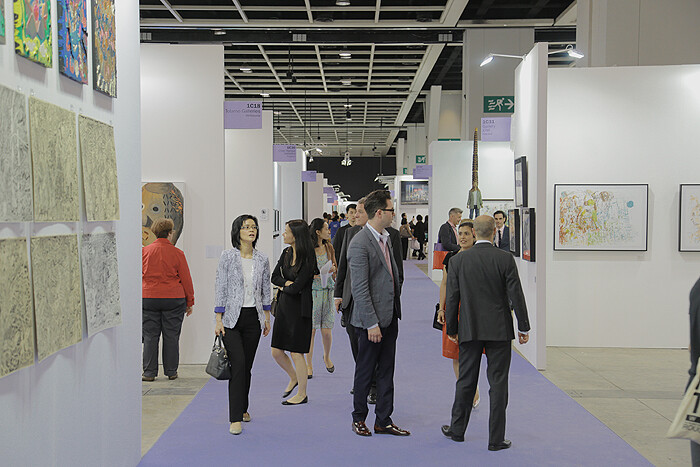
It was a debut, a big one. But the private preview opening of Art Basel Hong Kong was threatened with a black rainstorm warning, which yielded nothing other than the solid banality of Hong Kong humidity. Inside, relief: the Art Basel HK fair feels like a nineteenth-century crystal palace, spacious, inclusive, airy, with the eternal sunshine of allure. The fair takes up two floors (first and third) in the exhibition center in Wan Chai, where all commercial fairs happen in Hong Kong.
I would be lying if I were to say that I could cover the entire fair in a thousand words, however one can point to the highlights of the fair’s four sections. The Galleries sector is made up of 170 galleries beyond the toddler stage. Art-star chasers are justly rewarded here, with A, B, missing our C and D, adding E and jumping to K, M, and finally W: Abramović, Basquiat, Emin, Kapoor, Koons, Murakami, Warhol, the alphabetic dramaturgy of the blue chips’ greatest hits. It was my feet, however, that took that greatest beating, on four-inch heels for five hours, I felt tall but small. Aaron Curry’s works presented by Michael Werner offered up a messianic moment, when …